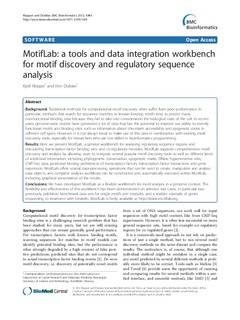MotifLab: a tools and data integration workbench for motif discovery and regulatory sequence analysis
Journal article, Peer reviewed
Permanent lenke
http://hdl.handle.net/11250/2366740Utgivelsesdato
2013Metadata
Vis full innførselSamlinger
Sammendrag
Background: Traditional methods for computational motif discovery often suffer from poor performance. In
particular, methods that search for sequence matches to known binding motifs tend to predict many
non-functional binding sites because they fail to take into consideration the biological state of the cell. In recent
years, genome-wide studies have generated a lot of data that has the potential to improve our ability to identify
functional motifs and binding sites, such as information about chromatin accessibility and epigenetic states in
different cell types. However, it is not always trivial to make use of this data in combination with existing motif
discovery tools, especially for researchers who are not skilled in bioinformatics programming.
Results: Here we present MotifLab, a general workbench for analysing regulatory sequence regions and
discovering transcription factor binding sites and cis-regulatory modules. MotifLab supports comprehensive motif
discovery and analysis by allowing users to integrate several popular motif discovery tools as well as different kinds
of additional information, including phylogenetic conservation, epigenetic marks, DNase hypersensitive sites,
ChIP-Seq data, positional binding preferences of transcription factors, transcription factor interactions and gene
expression. MotifLab offers several data-processing operations that can be used to create, manipulate and analyse
data objects, and complete analysis workflows can be constructed and automatically executed within MotifLab,
including graphical presentation of the results.
Conclusions: We have developed MotifLab as a flexible workbench for motif analysis in a genomic context. The
flexibility and effectiveness of this workbench has been demonstrated on selected test cases, in particular two
previously published benchmark data sets for single motifs and modules, and a realistic example of genes
responding to treatment with forskolin. MotifLab is freely available at http://www.motiflab.org.
